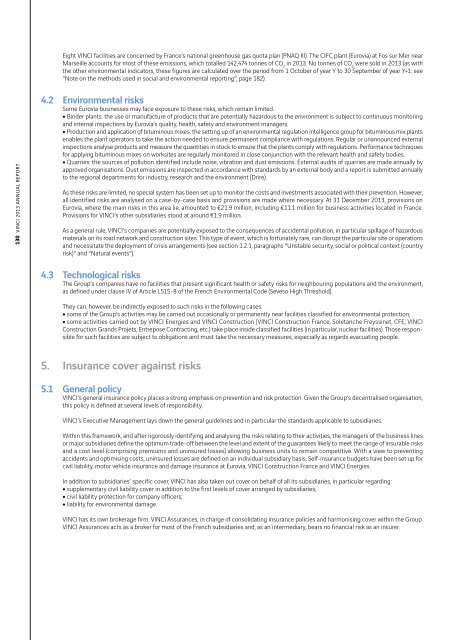2013-vinci-annual-report
2013-vinci-annual-report
2013-vinci-annual-report
You also want an ePaper? Increase the reach of your titles
YUMPU automatically turns print PDFs into web optimized ePapers that Google loves.
Eight VINCI facilities are concerned by France’s national greenhouse gas quota plan (PNAQ III). The CIFC plant (Eurovia) at Fos sur Mer near<br />
Marseille accounts for most of these emissions, which totalled 142,474 tonnes of CO 2<br />
in <strong>2013</strong>. No tonnes of CO 2<br />
were sold in <strong>2013</strong> (as with<br />
the other environmental indicators, these figures are calculated over the period from 1 October of year Y to 30 September of year Y+1: see<br />
“Note on the methods used in social and environmental <strong>report</strong>ing”, page 182).<br />
130 VINCI <strong>2013</strong> ANNUAL REPORT<br />
4.2 Environmental risks<br />
Some Eurovia businesses may face exposure to these risks, which remain limited.<br />
ˇˇBinder plants: the use or manufacture of products that are potentially hazardous to the environment is subject to continuous monitoring<br />
and internal inspections by Eurovia’s quality, health, safety and environment managers.<br />
ˇˇProduction and application of bituminous mixes: the setting up of an environmental regulation intelligence group for bituminous mix plants<br />
enables the plant operators to take the action needed to ensure permanent compliance with regulations. Regular or unannounced external<br />
inspections analyse products and measure the quantities in stock to ensure that the plants comply with regulations. Performance techniques<br />
for applying bituminous mixes on worksites are regularly monitored in close conjunction with the relevant health and safety bodies.<br />
ˇˇQuarries: the sources of pollution identified include noise, vibration and dust emissions. External audits of quarries are made <strong>annual</strong>ly by<br />
approved organisations. Dust emissions are inspected in accordance with standards by an external body and a <strong>report</strong> is submitted <strong>annual</strong>ly<br />
to the regional departments for industry, research and the environment (Drire).<br />
As these risks are limited, no special system has been set up to monitor the costs and investments associated with their prevention. However,<br />
all identified risks are analysed on a case-by-case basis and provisions are made where necessary. At 31 December <strong>2013</strong>, provisions on<br />
Eurovia, where the main risks in this area lie, amounted to €21.9 million, including €11.1 million for business activities located in France.<br />
Provisions for VINCI’s other subsidiaries stood at around €1.9 million.<br />
As a general rule, VINCI’s companies are potentially exposed to the consequences of accidental pollution, in particular spillage of hazardous<br />
materials on its road network and construction sites. This type of event, which is fortunately rare, can disrupt the particular site or operations<br />
and necessitate the deployment of crisis arrangements (see section 1.2.1, paragraphs “Unstable security, social or political context (country<br />
risk)” and “Natural events”).<br />
4.3 Technological risks<br />
The Group’s companies have no facilities that present significant health or safety risks for neighbouring populations and the environment,<br />
as defined under clause IV of Article L515-8 of the French Environmental Code (Seveso High Threshold).<br />
They can, however, be indirectly exposed to such risks in the following cases:<br />
ˇˇsome of the Group’s activities may be carried out occasionally or permanently near facilities classified for environmental protection;<br />
ˇˇsome activities carried out by VINCI Energies and VINCI Construction (VINCI Construction France, Soletanche Freyssinet, CFE, VINCI<br />
Construction Grands Projets, Entrepose Contracting, etc.) take place inside classified facilities (in particular, nuclear facilities). Those responsible<br />
for such facilities are subject to obligations and must take the necessary measures, especially as regards evacuating people.<br />
5. Insurance cover against risks<br />
5.1 General policy<br />
VINCI’s general insurance policy places a strong emphasis on prevention and risk protection. Given the Group’s decentralised organisation,<br />
this policy is defined at several levels of responsibility.<br />
VINCI’s Executive Management lays down the general guidelines and in particular the standards applicable to subsidiaries.<br />
Within this framework, and after rigorously identifying and analysing the risks relating to their activities, the managers of the business lines<br />
or major subsidiaries define the optimum trade-off between the level and extent of the guarantees likely to meet the range of insurable risks<br />
and a cost level (comprising premiums and uninsured losses) allowing business units to remain competitive. With a view to preventing<br />
accidents and optimising costs, uninsured losses are defined on an individual subsidiary basis. Self-insurance budgets have been set up for<br />
civil liability, motor vehicle insurance and damage insurance at Eurovia, VINCI Construction France and VINCI Energies.<br />
In addition to subsidiaries’ specific cover, VINCI has also taken out cover on behalf of all its subsidiaries, in particular regarding:<br />
ˇˇsupplementary civil liability cover in addition to the first levels of cover arranged by subsidiaries;<br />
ˇˇcivil liability protection for company officers;<br />
ˇˇliability for environmental damage.<br />
VINCI has its own brokerage firm, VINCI Assurances, in charge of consolidating insurance policies and harmonising cover within the Group.<br />
VINCI Assurances acts as a broker for most of the French subsidiaries and, as an intermediary, bears no financial risk as an insurer.


